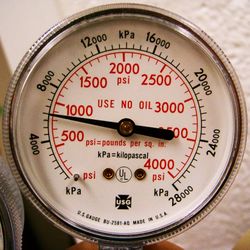
Pounds per square inch
Encyclopedia

Pressure
Pressure is the force per unit area applied in a direction perpendicular to the surface of an object. Gauge pressure is the pressure relative to the local atmospheric or ambient pressure.- Definition :...
or of stress
Stress (physics)
In continuum mechanics, stress is a measure of the internal forces acting within a deformable body. Quantitatively, it is a measure of the average force per unit area of a surface within the body on which internal forces act. These internal forces are a reaction to external forces applied on the body...
based on avoirdupois
Avoirdupois
The avoirdupois system is a system of weights based on a pound of 16 ounces. It is the everyday system of weight used in the United States and is still widely used to varying degrees by many people in Canada, the United Kingdom, and some other former British colonies despite the official adoption...
units. It is the pressure resulting from a force of one pound-force
Pound-force
The pound force is a unit of force in some systems of measurement including English engineering units and British gravitational units.- Definitions :...
applied to an area of one square inch
Square inch
A square inch is a unit of area, equal to the area of a square with sides of one inch. The following symbols are used to denote square inches:*square in*sq inches, sq inch, sq in*inches/-2, inch/-2, in/-2...
:
1 psi approximately equals 6,894.757 Pa
Pascal (unit)
The pascal is the SI derived unit of pressure, internal pressure, stress, Young's modulus and tensile strength, named after the French mathematician, physicist, inventor, writer, and philosopher Blaise Pascal. It is a measure of force per unit area, defined as one newton per square metre...
, where pascal
Pascal (unit)
The pascal is the SI derived unit of pressure, internal pressure, stress, Young's modulus and tensile strength, named after the French mathematician, physicist, inventor, writer, and philosopher Blaise Pascal. It is a measure of force per unit area, defined as one newton per square metre...
(Pa) is the SI
Si
Si, si, or SI may refer to :- Measurement, mathematics and science :* International System of Units , the modern international standard version of the metric system...
unit of pressure.
Magnitude
- Blood PressureBlood pressureBlood pressure is the pressure exerted by circulating blood upon the walls of blood vessels, and is one of the principal vital signs. When used without further specification, "blood pressure" usually refers to the arterial pressure of the systemic circulation. During each heartbeat, BP varies...
— Average human blood pressure (120/80): 2.32psi/1.55psi - Boost Pressure Provided By an Automotive TurbochargerTurbochargerA turbocharger, or turbo , from the Greek "τύρβη" is a centrifugal compressor powered by a turbine that is driven by an engine's exhaust gases. Its benefit lies with the compressor increasing the mass of air entering the engine , thereby resulting in greater performance...
(common):Pg = 6 - 15psi - Atmospheric pressure at sea level (standard): Pa = 14.7 psi
- Automobile tire overpressure (common): Pg = 32 psi
- Bicycle tire overpressure (common): Pg = 65 psi
- Workshop or garage air tools: Pg = 90 psi
- Air brake (rail)Air brake (rail)An air brake is a conveyance braking system actuated by compressed air. Modern trains rely upon a fail-safe air brake system that is based upon a design patented by George Westinghouse on March 5, 1872. The Westinghouse Air Brake Company was subsequently organized to manufacture and sell...
or Air brake (road vehicle)Air brake (road vehicle)Air brakes are used in trucks, buses, trailers, and semi-trailers. George Westinghouse first developed air brakes for use in railway service. He patented a safer air brake on March 5, 1872. Originally designed and built for use on railroad train application, air brakes remain the exclusive systems...
reservoir overpressure (common): 90 psi ≤ Pg ≤ 120 psi - Road racing bicycle tire overpressure: Pg = 120 psi
- Steam locomotive fire tube boiler (UK, 20th century): 150 psi ≤ Pg ≤ 280 psi
- Union Pacific Big BoyUnion Pacific Big BoyBig Boy was the name of the Union Pacific Railroad's 4000-class 4-8-8-4 articulated steam locomotives, built between 1941 and 1944 by American Locomotive Company...
steam locomotive boiler: 300 psi - Natural gas pipelines: 800 to 1000 psi
- Full SCBA Self Contained Breathing Apparatus for toxic atmospheres: 2216 psi
- Full scubaScuba setA scuba set is an independent breathing set that provides a scuba diver with the breathing gas necessary to breathe underwater during scuba diving. It is much used for sport diving and some sorts of work diving....
tank overpressure (common): Pg = 3000 psi - Commercial jet airliner hydraulic pressure: 3000 psi
- Airbus A380Airbus A380The Airbus A380 is a double-deck, wide-body, four-engine jet airliner manufactured by the European corporation Airbus, a subsidiary of EADS. It is the largest passenger airliner in the world. Due to its size, many airports had to modify and improve facilities to accommodate it...
hydraulic system: 5000 psi - Water jet cutterWater jet cutterA water jet cutter, also known as a waterjet, is a tool capable of slicing into metal or other materials using a jet of water at high velocity and pressure, or a mixture of water and an abrasive substance. The process is essentially the same as water erosion found in nature but greatly accelerated...
: 40,000 psi - 100,000 psi - Young's ModulusYoung's modulusYoung's modulus is a measure of the stiffness of an elastic material and is a quantity used to characterize materials. It is defined as the ratio of the uniaxial stress over the uniaxial strain in the range of stress in which Hooke's Law holds. In solid mechanics, the slope of the stress-strain...
for steel: 30 Mpsi or 30,000,000 psi
See also
- Conversion of units: Pressure or mechanical stress
- Pressure: Units

